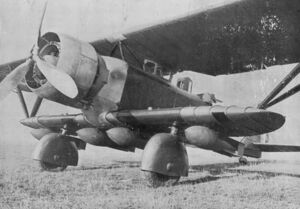Engineering:Breguet 270 Series
The Breguet 27 was a 1930s France biplane military reconnaissance aircraft, built for the Armée de l'Air (French Air Force) and for export to Venezuela and China .
Design and development
The Breguet 27 was designed in response to a 1928 request for proposals by the Armée de l'Air. Breguet submitted a large all-metal sesquiplane with an unusual fuselage that ended abruptly, aft of the two open cockpits. The empennage was mounted on a boom behind the fuselage. Construction was largely of steel tubing with non-structural aluminium alloy sheeting and fabric covering for wings and empennage.
The prototype exhibited mediocre performance during flight trials. Nonetheless the military placed orders for 85 aircraft in 1930 and 45 in 1932, this latter batch having a more powerful engine fitted. Two high-altitude reconnaissance versions were also built as the Breguet 33, but these did not lead to further production.
Operational history
Breguet 27s continued in military service through the outbreak of World War II, still equipping three Groupes at the time of the initial German offensive. After they began suffering combat losses, the Army withdrew all remaining examples from service.
The two Breguet 33 high-altitude reconnaissance prototypes were used to make significant long-distance flights. The first aircraft was flown from Paris to Hanoi in January 1932 by Paul Codos and Henri Robida in 7 days, 9 hours and 50 minutes, and back again in just 3 days 4 hours and 17 minutes. The second aircraft (christened Joé III) was flown by Maryse Hilsz on a tour of Asia, visiting Calcutta, Saigon, Hanoi, and Tokyo before returning to Paris via Saigon, eventually covering around 35,000 km (22,000 mi). Hilsz also won the 1936 Coupe Héléne Boucher flying a Breguet 27 at an average speed of 277 km/h (172 mph).
The French army ordered 85 270s in 1930. In 1932, 45 Breguet 271s, with a more powerful 484 kW (650 hp) engine, and larger useful load were ordered. Older 270s were modified for VIP liaison duties.
Variants
- Breguet 27S
- A single Bre.27S was constructed, modified from the Bre.330 No.2, powered by a single Hispano-Suiza 12Nb engine.
- Bre.270
- Prototypes (ten built) and initial production version (143 built) powered by a single Hispano-Suiza 12Hb engine.[1]
- Bre.271
- Version powered by the Hispano-Suiza 12Y engine, 45 built.
- Bre.272
- Version powered by the Gnome-Rhône 9Kdrs engine, two built.
- Bre.272TOE
- (Théatres des Operations Extérieures) Version optimised for harsh colonial conditions with Renault 9Fas radial engine, 1 built.
- Bre.273
- Reconnaissance-bomber variant for export, powered by a Hispano-Suiza 12Ybrs engine, 13 built and one converted from a Bre 270. Ten more were built for China powered by Hispano-Suiza 12Ydrs engines, with three also being modified from Hispano-Suiza 12Ybrs powered versions.
- Bre.274
- Version powered by the Gnome-Rhône 14Kdrs engine, raced by Maryse Hilsz in 1936, one built.
- Bre.330
- High-altitude version of Breguet 27 with Hispano-Suiza 12Nb engine, one later redesignated Bre.27S, two built.
- Bre.330.01
- Second Bre.330 prototype optimised for long-duration flight.
Operators
 Brazil
Brazil
- Brazilian Air Force received small batch of Bre.270 aircraft.
- Chinese Nationalist Air Force received six Bre.273 aircraft.
 France
France
- Armée de l'Air received 85 Bre.270 designated Bre.270A.2 and 45 Bre.271 designated Bre.271A.2.
 Venezuela
Venezuela
- Venezuelan Air Force operated three Bre.270 aircraft and 15 Bre.273 aircraft.
Specifications (Bre.270A.2)
General characteristics
- Crew: two, pilot and observer
- Length: 9.76 m (32 ft ¼ in)
- Wingspan: 17.01 m (55 ft 9¼ in)
- Height: 3.55 m (11 ft 5¾ in)
- Wing area: 49.67 m2 (534.66 ft2)
- Empty weight: 1,756 kg (3,871 lb)
- Gross weight: 2,393 kg (5,276 lb)
- Powerplant: 1 × Hispano-Suiza 12Hb, 373 kW (500 hp)
Performance
- Maximum speed: 236 km/h (147 mph)
- Range: 1,000 km (621 miles)
- Service ceiling: 7,900 m (25,920 ft)
- Rate of climb: 3.4 m/s (670 ft/min)
Armament
- 1 × fixed, forward-firing 7.7 mm (.303 in) Vickers machine gun
- 2 × trainable, rearward-firing 7.7 mm (.303 in) Lewis Guns for observer
- 120 kg (264 lb) of bombs
See also
Related lists
References
- Notes
- ↑ Donald, David, ed (1997). The Encyclopedia of World Aircraft. Prospero Books. pp. 118. ISBN 1-85605-375-X.
- Bibliography
- Taylor, Michael J. H. (1989). Jane's Encyclopedia of Aviation. London: Studio Editions. pp. 199.
- World Aircraft Information Files. London: Bright Star Publishing. pp. File 890 Sheet 81.
External links
- [Aviafrance.com Breguet]




